Bengali chicken curry done restaurant style brings home cooking to the next level. All the wonderful, authentic flavours. And an incredible, lush gravy. What’s not to love?
This isn’t on any restaurant menus. At least where I live. But it should be. It has all the big tastes you expect. But with a twist. Familiar but completely different. And really good.

Bengali chicken curry re-imagined
Bengali chicken curry done restaurant style is a riff on food I grew up eating. The flavours of my childhood. But how they would make it in a restaurant. If only restaurants made it…
Back then it was called murgir jhol. Or just chicken curry. Because when I was growing up this was the definitive chicken curry.
Everybody made it. Some did it better than others. But the backbone was always there. That wonderful Bengali five spice called panch phoran. Garlic. Ginger. Potatoes. Always potatoes. A hint of cinnamon. And chicken.
Sometimes green chili. A bit of sugar. Or mustard oil. Mustard oil is a nice touch. I’ve made it optional here but a 50/50 mix of mustard oil and vegetable oil adds a nice touch.
Murgir jhol is a runny curry. Almost soupy. Which is very different from restaurant style curries. If you’ve only had restaurant style curries try a runny one some time. Totally different experience. Like lemon coriander chicken curry. Tasty stuff.
This version is restaurant style. And that means rich, thick gravy. That’s what you will get here. I should do a homestyle version though. So you can compare. Both good.
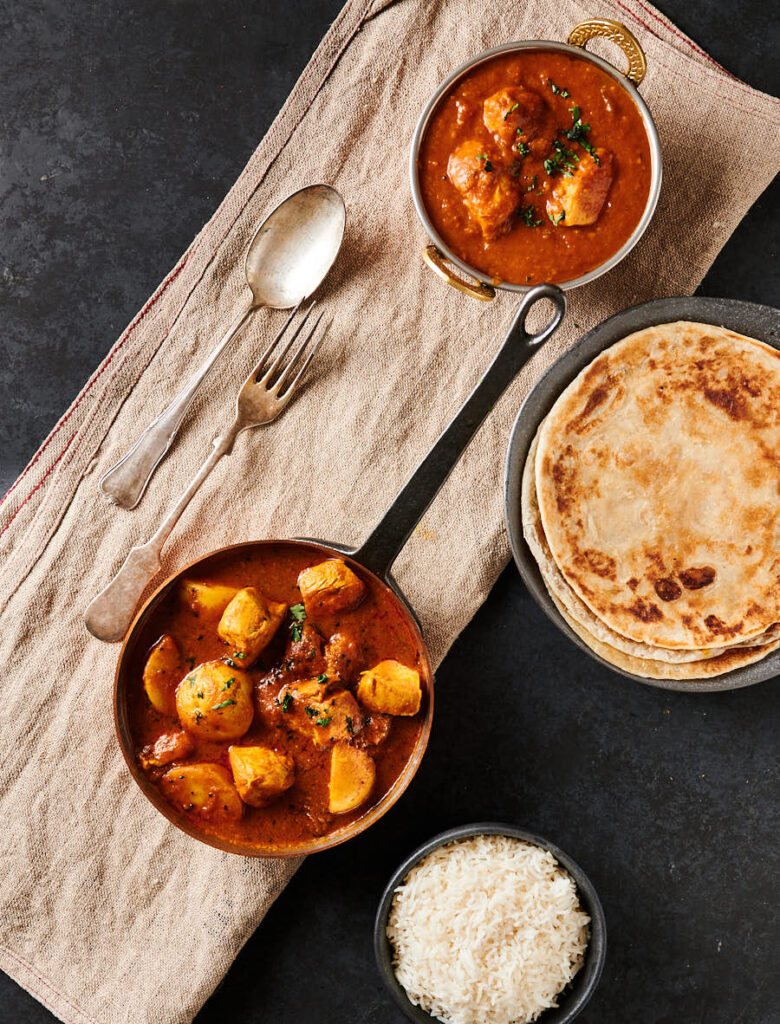
Don’t let the simplicity of this chicken curry recipe fool you
There isn’t a long list of ingredients in Bengali chicken curry. So you might think the flavours are a bit ho hum.
You would be wrong. I am into big flavours. That’s pretty much what glebe kitchen is about. Bland is not a word I ever want to hear.
There’s Bengali five spice. That’s five spices in one. And there’s restaurant mix powder. Another seven spices. It’s just streamlined. Like they would do in restaurants. So it doesn’t take 30 minutes to measure out ingredients.
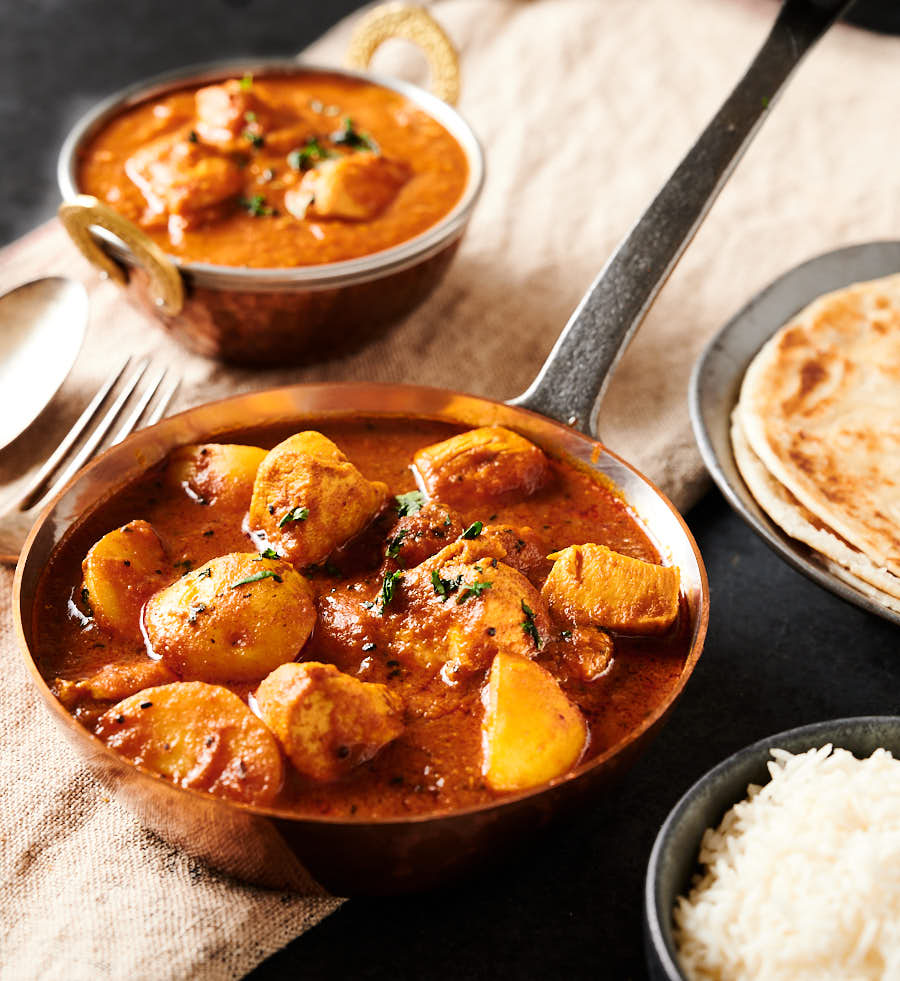
Panch phoran makes this Bengali chicken curry special
Panch phoran is the Bengali signature spice blend. Never heard of it? Not surprising. It’s big in Eastern India and Bangladesh. But you don’t see it often elsewhere.
That’s too bad. It is seriously tasty stuff. Secret weapon tasty in my book.
It’s not that exotic. Just a blend of whole spices. You can get it at any Indian grocer. Or you can make it yourself.
It’s a mix of fenugreek seed, cumin seed, mustard seed, nigella seed and fennel seed. Nothing so unusual. Except maybe nigella seed. You won’t find that at a bulk store.
Not exotic maybe. But distinctive. Flavourful. Surprisingly so. Try it. It’s addictive. And it’s what brings the magic to Bengali chicken curry.
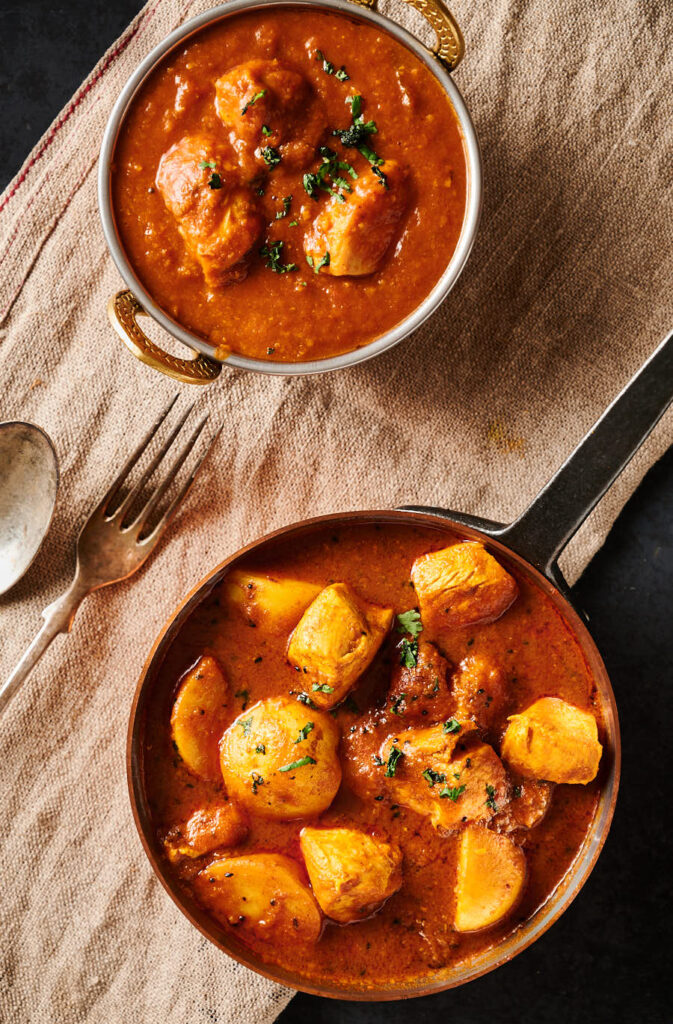
This is a dish to make when you want something new
Bengali chicken curry. This is not standard Indian restaurant fare. Different. But delicious.
The spicing is unique. But if you try it you’ll get a glimpse into a totally different set of flavours.
Indian restaurants have a formula. And it’s all pretty similar. Which is wrong. Makes me crazy. Would you go out for Italian if every restaurant had the same menu? A world where Olive Garden reigned supreme? Not a happy place in my mind.
Indians don’t eat the same 20 dishes you see on every Indian restaurant menu. And you shouldn’t either.
Try this. Or another dish you’ve never seen on a restaurant menu. There is so much more to Indian cooking. Give your tastebuds a treat.
bengali chicken curry – restaurant style
Ingredients
The spice mix
- 1 tsp panch phoran – Bengali spice mix available at Indian grocers
- 1 tsp kashmiri chili powder
- 2 tsp Indian restaurant spice mix recipe link below
- 1/2 tsp brown mustard seeds
- 1/16 tsp cinnamon powder – just a pinch really. Use 1/2 your 1/8 tsp measuring spoon to be precise.
- 1/2 tsp kosher salt
The curry ingredients
- 4 Tbsp neutral oil or use a 50/50 mix neutral and mustard oil
- 1 Tbsp garlic/ginger paste – recipe link below
- 1 1/2 Tbsp tomato paste Diluted in about 3 tbsp water
- 15 oz curry base – recipe link below
- 10-12 oz pre-cooked chicken see note
- 1 small to medium potato cut into 8 bite size chunks and pre-cooked in well salted water
Instructions
Do your prep
- Pre-cook your chicken. Cut the chicken into large bite size pieces. Put them in a pan with enough chicken stock or water to cover. Add a bit of spice mix or curry powder and a pinch of salt. Simmer until just barely done. The chicken cooks again briefly in the gravy.
- Pre-cook your potatoes. Cut them into pieces about the same size as the chicken. Add them to a small sauce pan and cover with well salted water. Bring to a simmer. The potatoes are done when a fork slides into them easily.
- Make the spice mixes. Combine the restaurant spice mix, kashmiri chili powder, cinnamon and salt in one small bowl. This is your powdered spice mix. Combine the mustard seeds and panch phoran in another small bowl.
- Combine 1 1/2 tablespoons of tomato paste with about 3 tablespoons of water.
Make the Bengali chicken curry
- Heat your frying pan (don’t use non-stick) briefly over medium heat. Add the oil.
- Once the oil starts to shimmer add the panch phoran and mustard seed mix. You should see little bubbles forming around the spices. Cook 15-20 seconds.
- Now add the garlic ginger paste. Cook, stirring constantly, until it stops sputtering. This should take 30 seconds or so.
- Add the powdered spice mix. This is the critical step. Stir it constantly for 30 seconds. If it starts to darken lift the pan off the heat. You want the spice mix to cook in the oil but not burn. You can go a little longer if you want. Really cook out the spices. Just be careful. Burnt spices are not tasty.
- Turn the heat up to medium high. This is important. The heat is what caramelizes (maillard reaction really) the onions in the curry base and gives the curry it's Indian restaurant flavour. As you become more comfortable with this technique try pushing it. Add the diluted tomato paste and stir until bubbles form (the oil will likely separate). This takes around 30 seconds to one minute depending on the heat.
- Add around 3 oz of curry base (you don't need to be super precise here). Stir until bubbles form (little craters really), around 30 seconds. Think lively boil. Watch the edges of the pan. The curry can stick here. Sticking is OK. Just scrape it back into the base. Burning is bad.
- Now add 6 oz of curry base and stir briefly. Let it cook until the bubbles form again. This takes 1-2 minutes.
- Add the rest of the curry base and let cook until the bubbles form. Turn the heat down to low and add the pre-cooked chicken and potatoes.
- Let the curry simmer for about 5 minutes. If it gets too thick add a bit more curry base. Don’t add water.
- Garnish with a bit of chopped fresh cilantro if you like. Serve with rice or Indian flatbread (or both!).
Notes
Nutrition
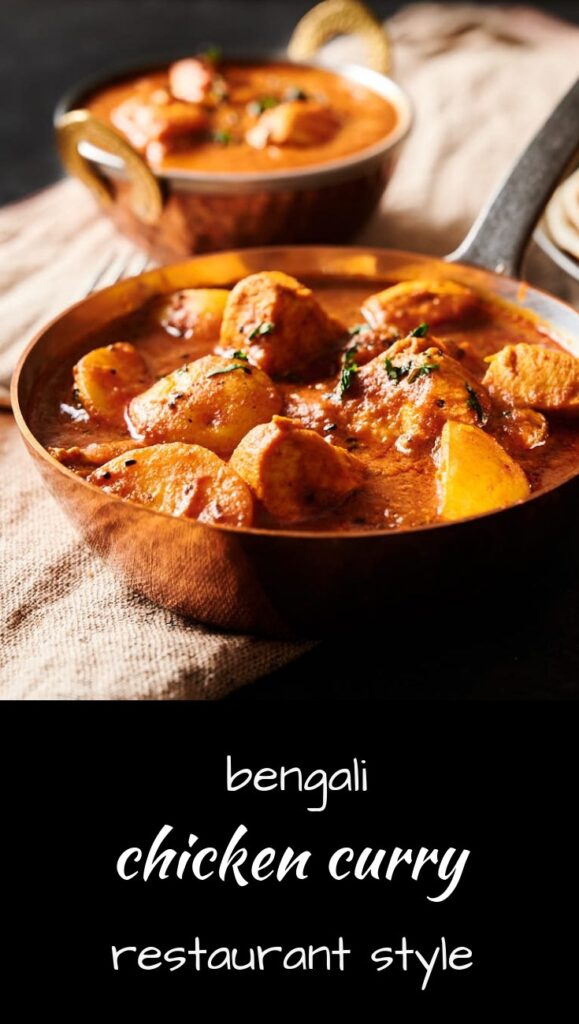

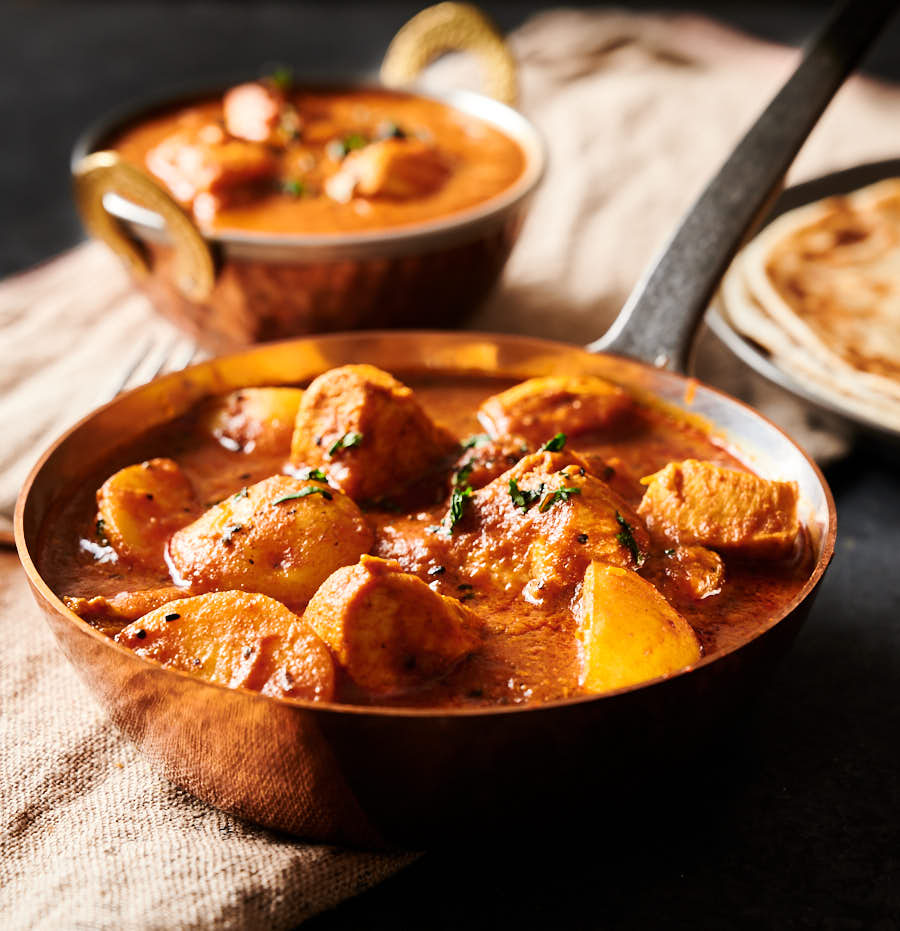
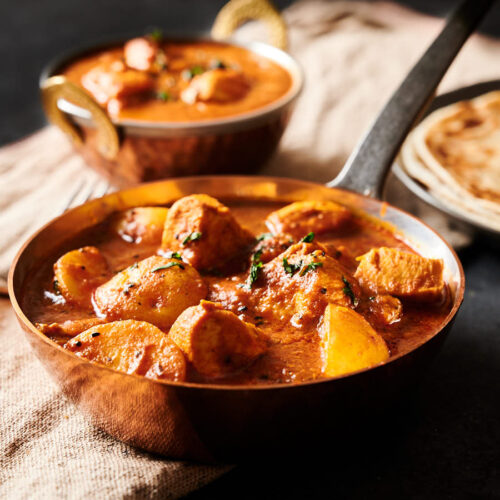
I was thinking about breaking the restaurant technique sequence in this recipe and frying the whole spices together with ground spices when there’s already more stuff in the pan so they don’t get as hot. Just because they are so small. I was trying to be careful, but because of their size maybe they did overcook super fast.
I’ll have to watch these small spices like a hawk in the future! Still, very tasty and a different kind of a spice profile which tastes unique, so I’ll have to revisit this recipe. And cooking with mustard oil was fun – even its smell is spicy.
Interestingly, I liked this more on the 2nd day! I’m not sure exactly what it is, but yesterday when I made it and had it right away, I detected some bitter notes, but it didn’t taste like burned spices. Today it tastes fantastic! I think it’s the brown mustard seeds that gave a bit of a bitter note because I remember tasting it a bit in your recipe of bombay aloo which also has them. But then again – I really liked the subtle crunch they added, so I can’t say I don’t appreciate them in a dish. I also added mustard oil here, which has a nice spiciness and I enjoyed the aroma. So overall my taste buds are a little confused with this dish – yesterday it was pretty good, today it’s great. Do you think it could be the mustard seeds/oil, and they just mellowed out by the 2nd day? It was still very flavorful, not bland at all.
I do find if you fry the panch phoran/mustard seed too hard it does get bitter. Maybe that’s what you are detecting?
Have so far made chicken madras, chicken tikka masala, chicken chili masala and now just had a bengali chicken it was unbelievable, never thought it was possible to get to this standard, it is so much better than the takeaway.
Thank you for all your effort and advice
Regards jeff
You are very welcome. Bengali chicken is one of my absolute favourites. Glad you liked it!
Hi Romain, I’ve been having difficult getting my hands on brown mustard seeds. Will the yellow ones work the same? Or is there another substitute I can use? I have a LOT of spices in my cupboard at the moment – even the nijella seeds.
Brown mustard seeds have a more pungent taste. So yellow mustards seeds won’t work quite the same. I’ve never tried so I don’t know how big a difference it would make though. There’s a lot of other spices in this recipe so it won’t be way under spiced certainly. Just a little less special.
Correction to previous message. The missus assures me the pan in question is in fact anodised aluminium, not non-stick after all. The curry was delicious anyway.
Happy Christmas all from Wimbledon.
So glad you liked it! Once you get the base technique down you can make just about anything.
I avoid non-stick because I want the curry base to stick a bit. There’s a reaction called Maillard that happens when sugars and amino acids hit heat (think of the browning when you fry a steak) that is critical to the flavours. I find it doesn’t happen as well in a non-stick pan (again, think of a steak in a non-stick pan).
Ah! I get it. Thanks for the answer Romain.
I’m a long time curry-wallah and I wish I’d heard of this technique before! Clever stuff. Both easy and delicious. I can’t wait to try some of your other recipes based on the restaurant method.
One question. Why do you say not to use non-stick? It’s what I had so I shrugged and went ahead regardless. Turned out fine.
Really enjoy your recipes and curry base is amazing.
Was just wondering on step 5 the recipe says to turn up the heat to caramelize the onion base, but there is no mention of onions elsewhere in the recipe.
The onion base is the curry base (just a lot of onions with some seasonings really). I’ve clarified it in the recipe.
I have been eating and cooking curry for over 40 years and have always wondered why my dishes (even when they are really nice) are not like the dishes in restaurants and take-aways. Now I know! The curry base recipe is genius! I have made a few of the dishes and they have been good although not exactly like my local restaurant. But the restaurant style Bengali Chicken Curry was absolutely spot on. Apart from the curry base, it’s the panch pora that is key. Really delicious and I will be trying other recipes soon!
It’s really amazing how different the curries turn out when you use a curry base. Glad you liked it and I hope you find others you like as much!
This curry was delicious. I enjoyed the flavour profile. Will look forward to a home style recipe.
Glad you liked it. It won’t be long before the homestyle recipe goes up.
Hello do I need to grind the Panch phoran or add as while spices?
Panch phoran goes in along with the mustard seeds as whole spices.
Can you give us the panch phoran spice mix recipe please??
Super easy. Equal parts whole brown mustard seed, cumin seed, fenugreek seed, fennel seed and nigella seed (also known as kalonji). You can buy it pre-mixed at most Indian groceries